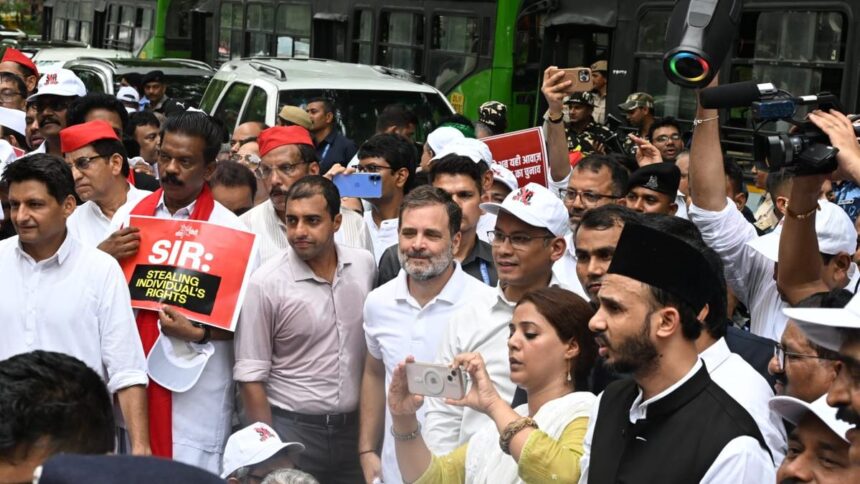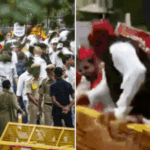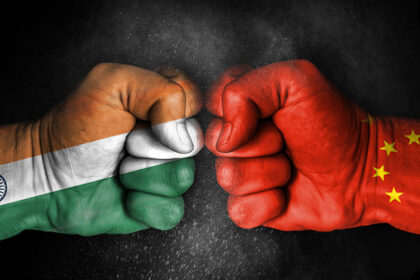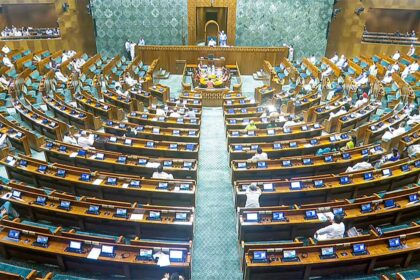Opposition INDIA Bloc’s August 11 Protest March: Building Momentum and Strategic Positioning
The streets of New Delhi carried a tense yet determined energy on the morning of August 11, 2025. The monsoon clouds hung low, hinting at rain, but the political storm that was about to unfold was far more intense. Leaders and workers of the Indian National Developmental Inclusive Alliance (INDIA) Bloc had gathered in large numbers, converging from different corners of the capital. Their destination was the Election Commission of India (ECI) headquarters — a symbolic and strategic choice that underscored the gravity of their accusations.
The core issue at the heart of this protest was the bloc’s charge of “vote chori” — a colloquial phrase that translates to “vote theft.” It was a term loaded with both political emotion and electoral significance. The opposition claimed that in several recent elections, the ruling dispensation had engaged in large-scale electoral malpractice, ranging from manipulation of electronic voting machines (EVMs) to the misuse of state machinery to influence results. While the ruling party dismissed these allegations as baseless and politically motivated, the opposition saw this as an assault on democracy itself.
The Gathering Momentum
The protest did not emerge overnight. In the days leading up to the march, there was a calculated build-up. Opposition leaders held press conferences, released video statements, and organized district-level gatherings to rally support. Posters bearing slogans like “Save Democracy, Stop Vote Chori” appeared in state capitals. Social media, too, became a battleground, with hashtags such as #StopVoteChori and #MarchToECI trending for days.
For the INDIA Bloc, this was more than a one-day agitation — it was part of a broader campaign to position themselves as the guardians of democratic integrity ahead of the upcoming state assembly and general elections. Strategists within the bloc privately acknowledged that while the immediate objective was to pressure the Election Commission into action, the long-term aim was to galvanize public opinion and erode the credibility of the ruling party.
Unity in Diversity — A Rare Political Moment
One of the most striking aspects of the march was the unity displayed by opposition leaders who, under normal circumstances, were fierce rivals in their respective states. Congress, Trinamool Congress (TMC), Samajwadi Party (SP), Rashtriya Janata Dal (RJD), Dravida Munnetra Kazhagam (DMK), Shiv Sena (UBT), and several Left parties set aside regional differences to present a united front. The optics of Mamata Banerjee walking shoulder-to-shoulder with Rahul Gandhi, or Akhilesh Yadav raising slogans alongside M.K. Stalin’s representatives, sent a powerful message to their shared voter base.
In political terms, such unity serves multiple functions. It not only consolidates anti-incumbency sentiment but also projects an image of collective strength capable of challenging the BJP’s electoral dominance. Political analysts pointed out that while the INDIA Bloc still has internal contradictions and ideological divergences, moments like these help in solidifying the alliance’s identity in the public imagination.
The March Begins
By mid-morning, the crowd outside the designated assembly point swelled to thousands. Placards, banners, and party flags painted the scene in a spectrum of colors, each representing a different political faction, yet waving in unison. Chants of “Tanashahi Nahi Chalegi” (Dictatorship Will Not Continue) and “Loktantra Bachao” (Save Democracy) echoed through the streets.
The march began slowly, partly due to the heavy security deployment. The Delhi Police had cordoned off several routes and imposed Section 144 in sensitive areas, citing security concerns. Barricades, riot-control vehicles, and water cannons stood ready, though the authorities maintained that they were only “prepared for any eventuality” and hoped for a peaceful demonstration.
At the Heart of the Protest — The Demand
As the leaders advanced, they made clear that their memorandum to the Election Commission would contain specific demands:
- An independent audit of recent election results in constituencies where alleged irregularities had been reported.
- Enhanced transparency in the functioning of EVMs, including public access to the source code and third-party technical verification.
- Strict enforcement of the Model Code of Conduct without bias towards any political party.
- Action against officials found to be complicit in electoral malpractice.
While these demands might seem procedural on paper, their political weight was enormous. If accepted, they could reshape the electoral landscape. If rejected, they would fuel the opposition’s narrative of a compromised democratic process.
Media Spotlight and Political Theatre
Television channels and online news portals covered the march in real-time, splitting their screens between studio debates and live visuals from the protest. Pundits debated whether this was a genuine fight for democracy or a strategic ploy to influence upcoming elections. Supporters saw it as a bold stand against authoritarian tendencies, while critics accused the bloc of manufacturing outrage to compensate for their electoral weaknesses.
The ruling party, for its part, issued a statement dismissing the allegations as “false, baseless, and part of the opposition’s attempt to mislead the public.” They accused the INDIA Bloc of undermining the Election Commission’s credibility for partisan gains.
An Unfolding Story
By the time the marchers reached the vicinity of the Election Commission headquarters, the day’s events had already carved their place in India’s ongoing political saga. But this was just the beginning. Behind closed doors, negotiations, confrontations, and deliberations were yet to unfold. The INDIA Bloc had made its first move in what promised to be a long and high-stakes battle over the soul of India’s democracy.
The planned protest march by the Opposition INDIA bloc on August 11, 2025, is not merely an expression of political dissent; it is a calculated move to project unity, consolidate voter sentiment, and challenge the ruling establishment ahead of upcoming electoral battles. Following the announcement of the march toward the Election Commission of India (ECI) headquarters, the alliance has been meticulously shaping its narrative, framing the protest as a defense of democracy, electoral fairness, and institutional integrity.
In the days leading up to the march, senior Congress leaders, along with representatives from allied parties, have been engaged in closed-door strategy sessions. These meetings aim to ensure that the march is not just a symbolic gesture but also a catalyst for political mobilization across states. Party veterans have emphasized the importance of clear messaging—tying the protest to allegations of bias, irregularities, and perceived erosion of democratic checks and balances. By focusing on these issues, the bloc seeks to galvanize public opinion, particularly among urban middle-class voters and younger demographics who are increasingly vocal about governance and transparency.
Media management has also emerged as a core component of the protest strategy. The alliance’s communication teams are coordinating press briefings, social media campaigns, and public statements to keep the issue alive in the news cycle. The use of hashtags, short video messages, and live updates during the march is designed to ensure that the event garners nationwide visibility. Furthermore, the bloc’s leadership is working to frame the march as an inclusive movement that goes beyond partisan lines, appealing to citizens concerned about the credibility of India’s democratic institutions.
Security and logistical planning have been equally crucial. Given the expected turnout of thousands of participants from various states, the organizers are liaising with local law enforcement to ensure a peaceful demonstration. Volunteer teams have been mobilized to provide medical assistance, manage crowd control, and facilitate communication among participants. The meticulous attention to detail reflects the bloc’s determination to avoid any incidents that could detract from its political message.
The ruling party’s counter-narrative, portraying the march as a politically motivated stunt, has been anticipated by the opposition, which is preparing point-by-point rebuttals. Leaders have been instructed to remain disciplined in their public statements, avoiding personal attacks and focusing instead on institutional accountability. This disciplined approach is part of a broader effort to project the INDIA bloc as a mature, responsible alternative to the current government.
As August 11 approaches, the protest march is shaping up to be a litmus test for the opposition’s ability to translate public discontent into a sustained political movement. Whether it will trigger tangible policy or electoral shifts remains uncertain, but its symbolic value as a demonstration of unity and resolve is undeniable. If executed successfully, it could mark a significant turning point in the political momentum leading into the next election cycle.
When August 11, 2025, dawned over New Delhi, the capital bore the signs of an impending large-scale political demonstration. Barricades were being erected across key junctions, security personnel were deployed in significant numbers, and television news channels had already set up live broadcast points along the protest route. By mid-morning, members of the Opposition INDIA bloc began gathering at the designated assembly point, a sea of party flags, placards, and coordinated slogans marking their arrival.
The march was carefully choreographed to maintain discipline and coherence. Senior leaders took their positions at the forefront, walking side by side to visually project unity across the alliance’s diverse political spectrum. Flanked by volunteers and media crews, the leaders engaged with journalists, delivering soundbites that reiterated their key message: the Election Commission must safeguard democracy, and the credibility of electoral processes cannot be compromised.
Public turnout exceeded initial estimates. While many participants were party workers mobilized from across states, a notable segment of the crowd consisted of independent citizens, student activists, and civil society members. Their presence lent credibility to the opposition’s claim that the protest was not simply an intra-political event but a broader civic movement. Many carried hand-painted signs with slogans emphasizing transparency, fairness, and institutional independence.
On social media, the march quickly became a trending topic. Hashtags related to the protest flooded X (formerly Twitter), Instagram, and Facebook, with short videos capturing moments such as speeches from the marching leaders, chants from the crowd, and aerial drone shots showing the march’s scale. The opposition’s digital teams maintained a steady stream of updates, while sympathetic influencers and political commentators amplified the event’s visibility.
Law enforcement handled crowd management with a combination of firmness and restraint. Checkpoints and barricades slowed the march at certain points, leading to brief stand-offs where leaders negotiated with police officers to allow continued movement toward the Election Commission. Although there were minor disruptions and heated exchanges in isolated pockets, no major incidents of violence were reported—a fact the opposition later highlighted as evidence of their commitment to a peaceful, democratic form of protest.
By the time the march reached the Election Commission’s premises, chants had grown louder and the visual presence of the alliance’s leadership became a focal point for media coverage. A formal memorandum outlining the bloc’s grievances and demands was submitted to ECI officials. The document reportedly detailed alleged instances of bias, sought reforms in the monitoring of electoral funding, and called for the assurance of level playing fields in upcoming elections.
The public reaction was mixed but impactful. Supporters applauded the march as a sign of democratic resilience, while detractors dismissed it as a performative spectacle. However, even among critics, there was acknowledgment that the INDIA bloc had managed to execute the event in an organized, high-visibility manner. Political analysts on prime-time debates noted that while such marches do not always lead to immediate institutional change, they serve as critical exercises in agenda-setting and voter engagement.
By nightfall, the city had returned to its usual rhythm, but the political ripples of the day’s events continued to spread. The opposition had succeeded in putting its concerns at the center of national political discourse, at least temporarily—a victory in the crowded, competitive arena of Indian politics.
The day after the August 11 protest march, the political atmosphere in New Delhi was charged with reactions from both the ruling government and the Opposition INDIA bloc. While the protest had been primarily symbolic, its scale and organization made it impossible for the ruling establishment to ignore. The government, however, sought to project composure, framing the march as “political theatrics” rather than a legitimate grievance.
Several Union Ministers addressed the media, asserting that the Election Commission of India (ECI) functioned independently and that any allegations of bias were baseless. They pointed to past instances where the Commission had ruled in favor of Opposition parties, using these examples to argue against claims of partiality. The government’s line was clear: the protest was less about protecting democracy and more about the Opposition trying to pre-emptively delegitimize upcoming electoral results.
The ECI itself issued a carefully worded statement. Without directly addressing the INDIA bloc’s accusations, it reiterated its commitment to conducting free and fair elections. The Commission highlighted ongoing reforms in voter verification, the deployment of modernized EVM technology with enhanced security features, and transparent monitoring of political funding. While the statement was intended to reassure the public, its neutrality also meant that it did little to directly defuse the political tension.
Within the INDIA bloc, leaders hailed the march as a success, pointing to widespread media coverage and strong public turnout as proof of growing discontent. Rahul Gandhi, speaking at a press conference, declared that the protest had “sent a clear message to those in power” that attempts to undermine democratic institutions would face united resistance. Other alliance leaders echoed similar sentiments, framing the protest as just the beginning of a sustained campaign.
Political analysts quickly weighed in. Some noted that while the march had elevated the INDIA bloc’s visibility, it also risked deepening the polarization between the government and opposition. Others argued that the protest strategically kept electoral integrity in the headlines at a time when the ruling party was focusing on economic growth and national security narratives. In their view, the march effectively forced the ruling party to respond to an issue it might otherwise have sidestepped.
Interestingly, international reactions began to surface. A few global human rights organizations issued brief statements expressing support for peaceful political protests as a cornerstone of democratic governance. Foreign media outlets, particularly those with an interest in South Asian politics, covered the march as part of a broader trend of democratic pushback against perceived centralization of power in the region.
Behind the scenes, there were signs of intensified political maneuvering. Reports emerged that the ruling party was preparing a counter-campaign highlighting what it described as the Opposition’s own history of undermining institutions when in power. At the same time, opposition strategists were reportedly drafting plans for follow-up events in other states to maintain momentum.
For the general public, the aftermath of the protest was a mix of heightened political engagement and deepening skepticism. Some citizens felt that while the march was a strong show of unity, its true impact would depend on whether it translated into legislative action or meaningful electoral reforms. Others remained unconvinced, viewing the entire event as another chapter in the endless cycle of political posturing.
As the week progressed, the August 11 protest began to fade from breaking news headlines, but its influence persisted in subtler ways. Party speeches, campaign narratives, and even local political discussions increasingly touched on the theme of electoral fairness. Whether or not the protest would bring concrete institutional change remained uncertain, but it had undeniably reshaped the political conversation—at least for the moment.
Also Read : Another UK F-35 Fighter Jet Makes Emergency Landing in Japan — 2nd Incident Weeks After India Snag








